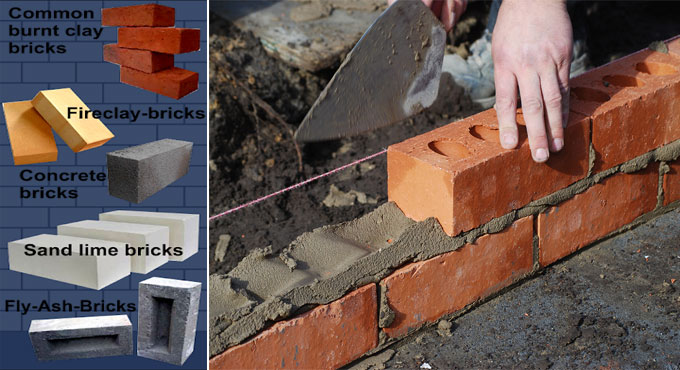
Types of Bricks used in Construction
Formally, the term brick is utilized to mean a structure unit made of molded earth, yet in current occasions it is utilized to allude to any stone-or mud based structure unit that is gotten together with cementitious mortar when utilized in construction.
Commonly, bricks are around four inches wide, eight inches in length, with an assortment of thicknesses. Bigger stone or earth based structure units of the sort utilized in establishments are generally called blocks.
How Bricks Are Categorized
There are various ways that brick can be classified. For instance, you can partition brick into the sorts utilized for confronting (uncovered and obvious on the outside of a structure) versus backing bricks (which are utilized basically and are escaped see).
Another method for classifying brick is as per how they are fabricated: unfired (brick that is air-restored) and terminated (brick that is heated in broilers so as to solidify it). Bricks can be likewise classified by their run of the mill use: normal bricks or building bricks.
For motivations behind private construction, it is normally regular bricks that are of most enthusiasm, since designing bricks are all the more frequently utilized in structural building ventures, for example, street or scaffold construction, or in sewers construction.
Bricks classified by shapes
1. Brick veneers: These bricks are meager and utilized for surface cladding.
2. Airbricks: These bricks contain huge openings to circle air and decrease weight. They are utilized in suspended floors and cavity dividers.
3. Perforated bricks: These bricks contain numerous barrel shaped openings penetrated all through the brick. They are exceptionally light in weight.
4. Bullnose brick: These are bricks formed with round edges.
5. Paving bricks: These bricks contain a decent measure of iron. They are utilized underneath paving applications.
6. Capping bricks: These bricks are utilized to top the highest points of unattached dividers.
7. Hollow bricks: About 33% of the heaviness of the typical bricks, these are utilized for the most part in parcel dividers where load-bearing isn't required.
Classifying Bricks by Raw Materials
In present day construction rehearses, regular bricks are classified by their segment materials and strategy for fabricate. Under this arrangement, there are five basic sorts:
Burnt Clay Bricks: Burnt clay bricks are the great type of brick, made by squeezing wet mud into molds, at that point drying and terminating them in ovens. This is an old structure material?the kind of brick found in a significant number of the antiquated structures of the world. In appearance, these bricks are strong blocks of solidified dirt, typically rosy in shading.
Burnt clay bricks are commonly sold in four classes, with five stars offering the best quality and most quality. These high-grade consumed mud bricks have no recognizable defects, but on the other hand they're going to cost more.
At the point when these bricks are utilized in dividers, they require putting or rendering with mortar.
Sand Lime Bricks: Sand lime bricks (otherwise called calcium silicate bricks) are made by blending sand, fly debris and lime. Shades may likewise be included for shading. The blend is then shaped to frame bricks; the materials bond together by a compound response that happens as the wet bricks dry under warmth and weight.
These bricks are not, notwithstanding, terminated in furnaces in a similar way as consumed dirt bricks. Sand lime bricks can offer a few favorable circumstances over earth bricks, for example, Their shading appearance is dark rather than the standard rosy shading. Their shape is uniform and presents a smoother finish that doesn't require putting.
These bricks offer incredible quality for load-bearing structures. At the point when colors are included, the bricks can be utilized for elaborate purposes. Less mortar is required during construction. Their edges are straight and exact, making construction simpler.
Concrete Bricks: Concrete bricks are produced using strong cement and are developing in notoriety among mortgage holders. Solid bricks are typically put in exteriors, fences, and give a magnificent tasteful nearness. These bricks can be fabricated to give various hues if colors are included during creation. Solid bricks ought not be utilized in subterranean applications.
Fly Ash Clay Bricks: Fly Ash Clay Bricks are produced with mud and fly ash ? a result of coal consuming ? terminated at around 1,000 degrees C. Since fly debris contains a high volume of calcium oxide, this sort of brick is in some cases depicted as self-solidifying, since it grows when presented to dampness.
This propensity to grow, be that as it may, can likewise deliver jump out disappointment. Fly debris earth brick has the upside of being lighter in weight than mud or solid brick.
Fire Bricks: Otherwise called refractory bricks, these are produced from exceptionally defined earth with a high aluminum oxide content. In the wake of consuming, these bricks can withstand high temperatures without their shape, size, or quality being influenced.
They are mostly used in the covering of stacks and heaters , pizza broilers and open air brick grills.


